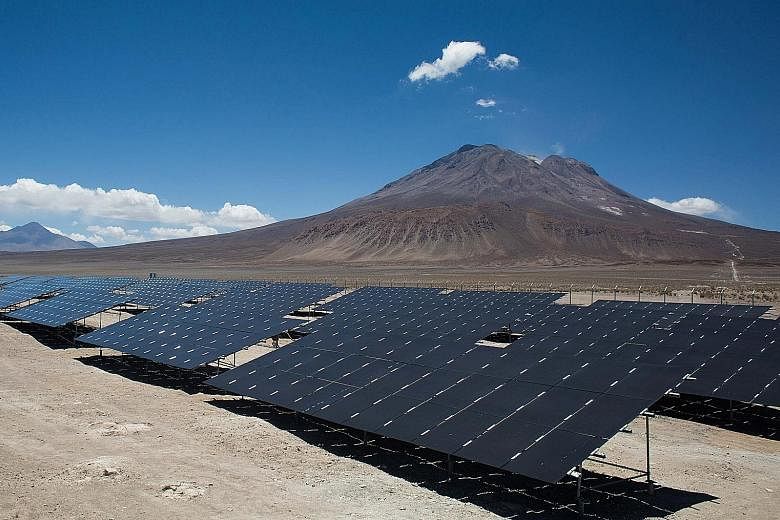LONDON • Solar power is now cheaper than coal in some parts of the world and, in less than a decade, it is likely to be the lowest-cost option almost everywhere.
Last year, countries from Chile to the United Arab Emirates broke records with deals to generate electricity from sunshine for less than three US cents (four Singapore cents) a kilowatt-hour, half the average global cost of coal power.
Saudi Arabia, Jordan and Mexico are planning auctions and tenders for this year, aiming to drop prices even further.
Companies such as Italy's Enel and Dublin's Mainstream Renewable Power that gained experience in Europe are seeking new markets abroad as subsidies dry up at home.
The speed at which the price of solar power will drop below coal varies in each country. Places that import coal or tax polluters with a carbon price, such as Europe and Brazil, will see a crossover in the 2020s, if not earlier. Countries with large domestic coal reserves such as India and China will probably take longer.
China, the biggest solar power market, will see costs falling below the costs of coal power by 2030, according to Bloomberg New Energy Finance. It has surpassed Germany as the country with the most installed solar capacity as the government seeks to increase use to cut carbon emissions and boost consumption of clean energy.
Since 2009, solar power prices have fallen by 62 per cent, with all parts of the supply chain trimming costs. That has helped to cut risk premiums on bank loans and pushed manufacturing capacity to record levels. By 2025, solar power may be cheaper than using coal on average globally, according to Bloomberg New Energy Finance.
"These are game-changing numbers, and it's becoming normal in more and more markets," said Mr Adnan Amin, director-general of the International Renewable Energy Agency, an Abu Dhabi-based intergovernmental group. "Every time you double capacity, you reduce the price by 20 per cent."
Better technology has been key in boosting the industry, from the use of diamond-wire saws that more efficiently cut wafers to better cells that provide more spark from the same amount of sunlight. It is also driven by economies of scale and manufacturing experience since the solar power boom started more than a decade ago, giving the industry an increasing edge in the competition with fossil fuels.
The average 1 megawatt-plus ground-mounted solar power system will cost 73 US cents a watt by 2025 compared with US$1.14 now, a 36 per cent drop, said Ms Jenny Chase, head of solar analysis for Bloomberg New Energy Finance.
The International Energy Agency expects utility-scale generation costs to fall a further 25 per cent on average in the next five years.
The International Renewable Energy Agency anticipates a further drop of 43 to 65 per cent for solar power costs by 2025. That would bring to 84 per cent the cumulative decline since 2009.
The supply chain is experiencing "a Walmart effect" from higher volumes and lower margins, according to Mr Sami Khoreibi, founder and chief executive officer of Enviromena Power Systems, an Abu Dhabi-based developer.
Sunbelt countries are leading the way in cutting costs, though there is more to it than just the weather. The use of auctions to award power-purchase contracts is forcing energy companies to compete with one another to lower costs.
An auction in Chile last August yielded a contract for 2.91 US cents a kilowatt-hour. In September, a United Arab Emirates auction grabbed headlines with a bid of 2.42 US cents a kilowatt-hour.
Developers' lower bids are backed by expectations that technology costs will keep falling.
BLOOMBERG

